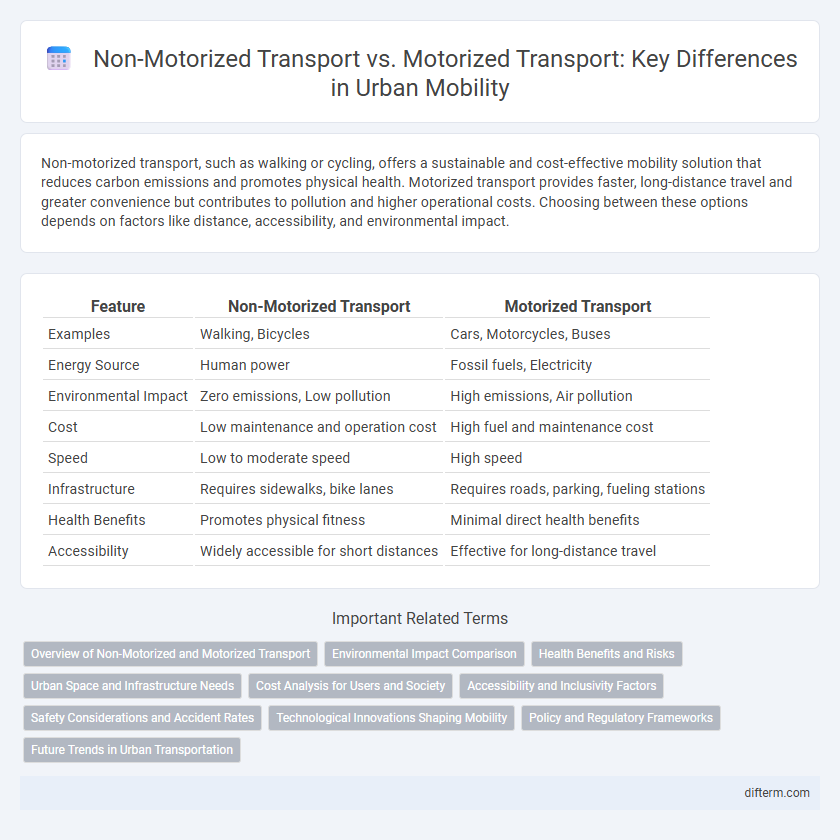Non-motorized transport, such as walking or cycling, offers a sustainable and cost-effective mobility solution that reduces carbon emissions and promotes physical health. Motorized transport provides faster, long-distance travel and greater convenience but contributes to pollution and higher operational costs. Choosing between these options depends on factors like distance, accessibility, and environmental impact.
Table of Comparison
| Feature | Non-Motorized Transport | Motorized Transport |
|---|---|---|
| Examples | Walking, Bicycles | Cars, Motorcycles, Buses |
| Energy Source | Human power | Fossil fuels, Electricity |
| Environmental Impact | Zero emissions, Low pollution | High emissions, Air pollution |
| Cost | Low maintenance and operation cost | High fuel and maintenance cost |
| Speed | Low to moderate speed | High speed |
| Infrastructure | Requires sidewalks, bike lanes | Requires roads, parking, fueling stations |
| Health Benefits | Promotes physical fitness | Minimal direct health benefits |
| Accessibility | Widely accessible for short distances | Effective for long-distance travel |
Overview of Non-Motorized and Motorized Transport
Non-motorized transport, including walking and cycling, offers sustainable mobility solutions by reducing carbon emissions and promoting public health through active travel. Motorized transport, encompassing cars, buses, and motorcycles, provides higher speed and longer-range connectivity but contributes significantly to air pollution and urban congestion. Integrating non-motorized and motorized modes enhances urban mobility efficiency and supports environmental goals.
Environmental Impact Comparison
Non-motorized transport such as walking and cycling produces zero greenhouse gas emissions, significantly reducing urban air pollution compared to motorized vehicles, which contribute approximately 14% of global CO2 emissions. Lifecycle assessments reveal that electric scooters and bicycles have a considerably lower carbon footprint than cars and motorcycles, primarily due to reduced energy consumption and the absence of fossil fuel combustion. Promoting infrastructure for non-motorized transport enhances sustainable mobility by decreasing reliance on fossil fuels and mitigating climate change effects caused by traditional motorized transport.
Health Benefits and Risks
Non-motorized transport, such as walking and cycling, significantly improves cardiovascular health by promoting physical activity and reducing obesity risk. Motorized transport contributes to air pollution and sedentary lifestyles, which increase the likelihood of respiratory diseases and cardiovascular problems. Prioritizing non-motorized mobility enhances public health outcomes by lowering exposure to traffic emissions and encouraging active living.
Urban Space and Infrastructure Needs
Non-motorized transport, such as walking and cycling, requires significantly less urban space compared to motorized vehicles, allowing for more efficient land use and reduced congestion in city centers. Infrastructure for non-motorized mobility, including bike lanes, sidewalks, and pedestrian zones, demands lower construction and maintenance costs while promoting safer, cleaner, and more accessible urban environments. In contrast, motorized transport relies heavily on extensive road networks, parking facilities, and traffic management systems, which often contribute to urban sprawl and environmental degradation.
Cost Analysis for Users and Society
Non-motorized transport such as walking and cycling incurs minimal direct costs for users, including negligible fuel and maintenance expenses, leading to significant individual savings. Society benefits from reduced healthcare expenditures due to improved public health, lower pollution-related costs, and decreased infrastructure wear compared to motorized transport. Conversely, motorized transport imposes higher economic burdens through fuel consumption, vehicle maintenance, traffic congestion, and environmental externalities affecting public budgets and quality of life.
Accessibility and Inclusivity Factors
Non-motorized transport modes such as walking and cycling significantly enhance accessibility in urban areas by providing affordable, space-efficient options that accommodate diverse socioeconomic groups. These modes promote inclusivity by reducing dependence on costly motorized vehicles, thereby improving mobility for low-income populations, the elderly, and people with disabilities. In contrast, motorized transport often requires expensive infrastructure and fuel costs, limiting accessibility and exacerbating social inequalities in urban mobility.
Safety Considerations and Accident Rates
Non-motorized transport modes like walking and cycling generally exhibit lower accident severity compared to motorized transport, though they face higher vulnerability due to limited protective barriers. Safety considerations emphasize dedicated infrastructure such as bike lanes and pedestrian zones to reduce collision risks and improve visibility. Statistical data reveals that while motorized vehicles account for a greater number of fatalities, non-motorized users suffer disproportionately high injury rates per distance traveled, highlighting the need for targeted safety interventions.
Technological Innovations Shaping Mobility
Technological innovations in mobility increasingly enhance non-motorized transport by integrating smart sensors, electric-assist systems, and app-based route optimization, promoting safety and efficiency. In contrast, motorized transport advances through electric vehicle adoption, autonomous driving technologies, and connected infrastructure aimed at reducing emissions and traffic congestion. These developments collectively drive a transformative shift toward sustainable and intelligent urban mobility ecosystems.
Policy and Regulatory Frameworks
Policy and regulatory frameworks for non-motorized transport emphasize the development of dedicated infrastructure, safety standards, and integration with public transit systems to promote sustainable urban mobility. In contrast, motorized transport policies often focus on emissions control, fuel standards, and traffic management to reduce environmental impact and congestion. Effective mobility strategies balance these approaches by incentivizing active transportation modes while regulating motorized vehicle use for enhanced urban livability and reduced carbon footprint.
Future Trends in Urban Transportation
Future urban transportation trends emphasize a shift towards non-motorized transport modes such as walking and cycling, driven by sustainability goals and reducing carbon emissions. Innovations in infrastructure design prioritize safe, accessible pedestrian pathways and bike lanes, promoting health and environmental benefits. Electric scooters and shared micro-mobility solutions complement non-motorized transport, integrating seamlessly with public transit to create multimodal urban mobility networks.
non-motorized transport vs motorized transport Infographic

 difterm.com
difterm.com